
by Krista | Apr 26, 2012 | Fabulous Friday
I love going on road-trips. Especially on gorgeously sunny days with the windows down and dear friends beside me.
One of my favorite road-trips of all time was through Albania. It was a wild, crazy adventure of unreadable maps, wrong turns, and roads that were little more than gigantic potholes strung together.
I loved it.
I got one of the window seats and happily leaned out of it for hours, capturing the people, animals, and landscape of this incredible country.
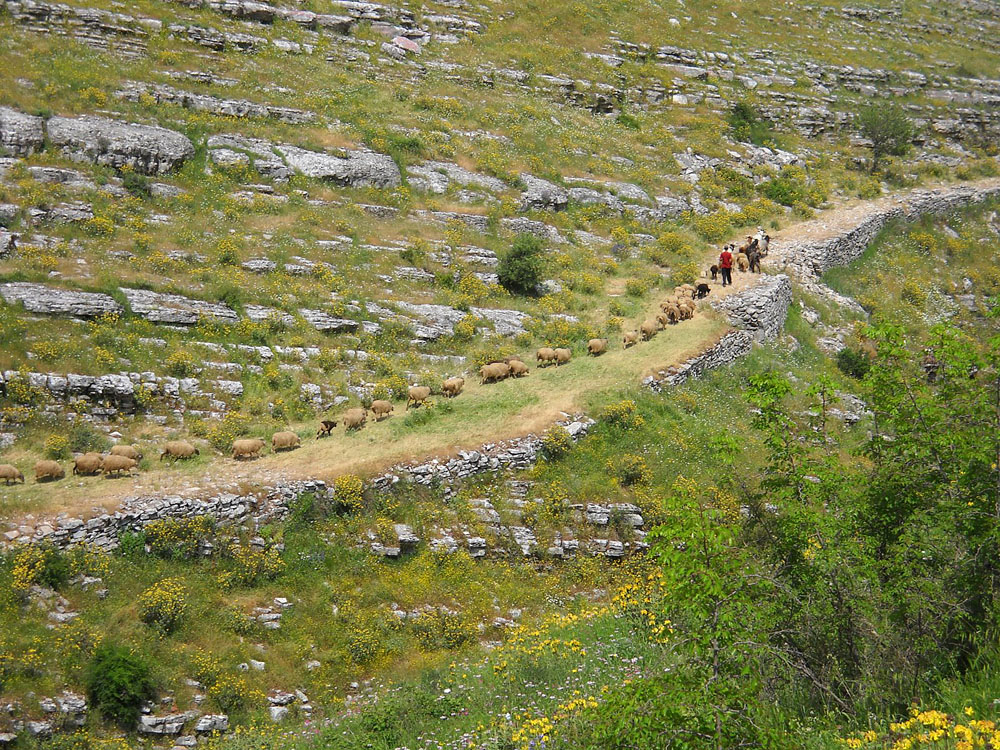
I was amazed by the ruggedly beautiful mountains ridged by rocky outcroppings and covered in wildflowers.
Best of all were the shepherds leading long trains of sheep along narrow trails. We watched them wend their way down the mountain, not one sheep toppling off.
Other shepherds sat out front of their makeshift tents, chatting amiably in the sunshine as their cattle nibbled grass nearby.
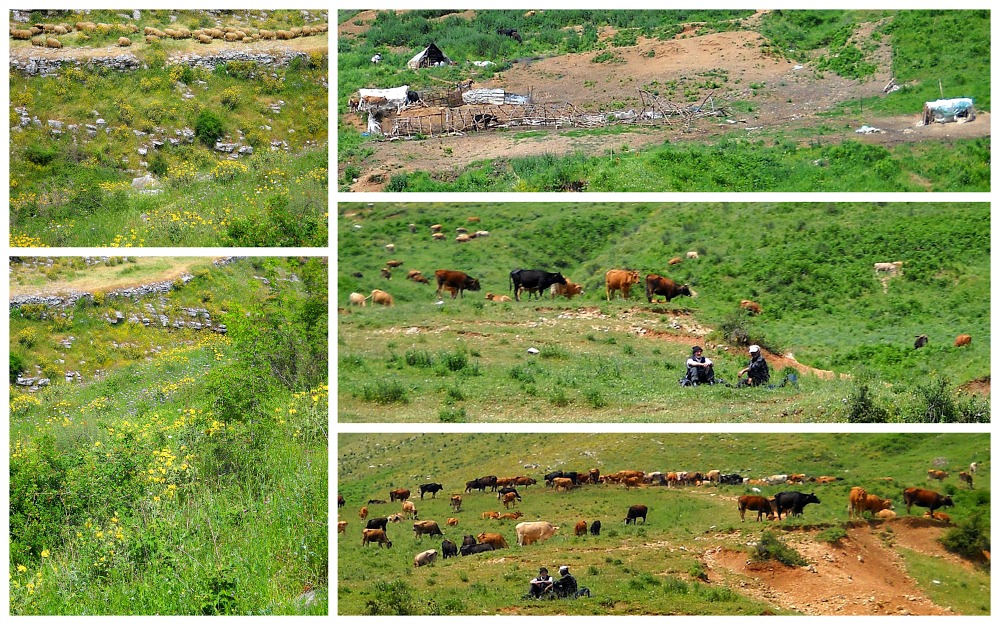
Such a wildly beautiful place.
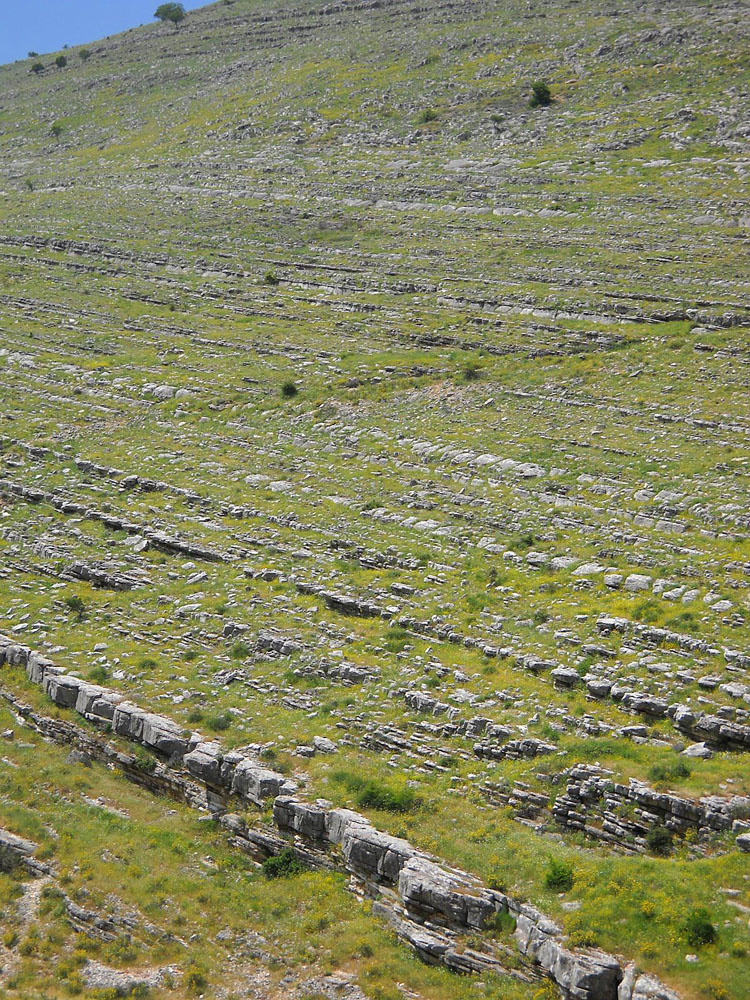
As we climbed higher and higher I looked back into the valley, in awe of the mountain towering up behind us, its distinctive features disappearing in a haze of blues and greens.
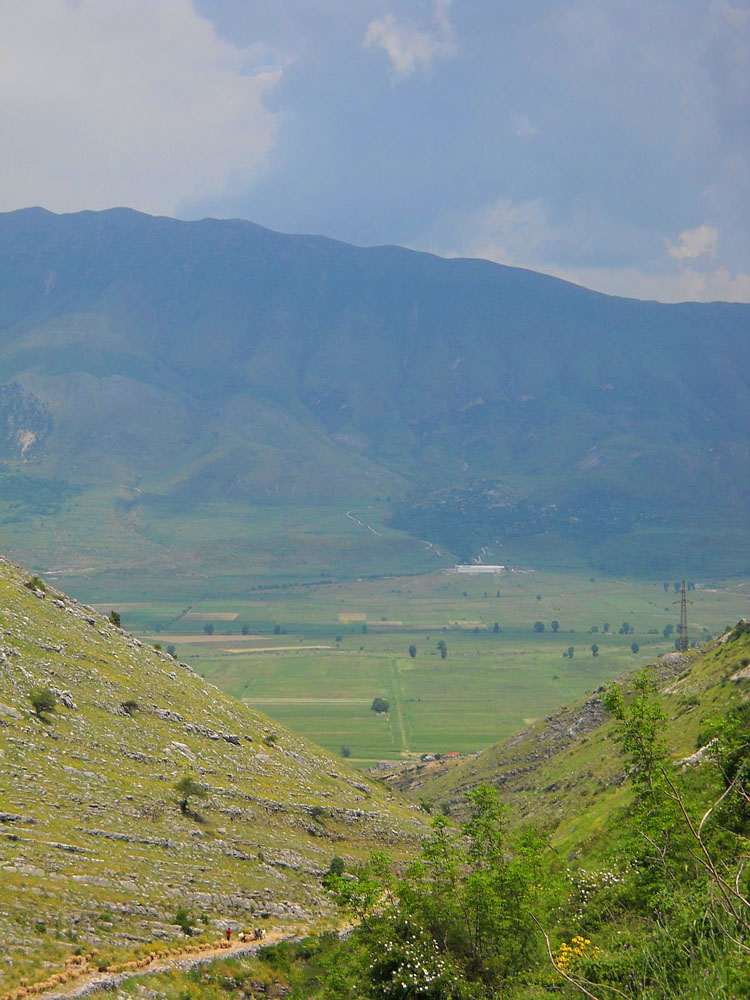
I smiled as we rounded another bend, this time spotting a man leading a train of heavily-laden mules. I wondered where they were going. Where they came from. What was in those bags.
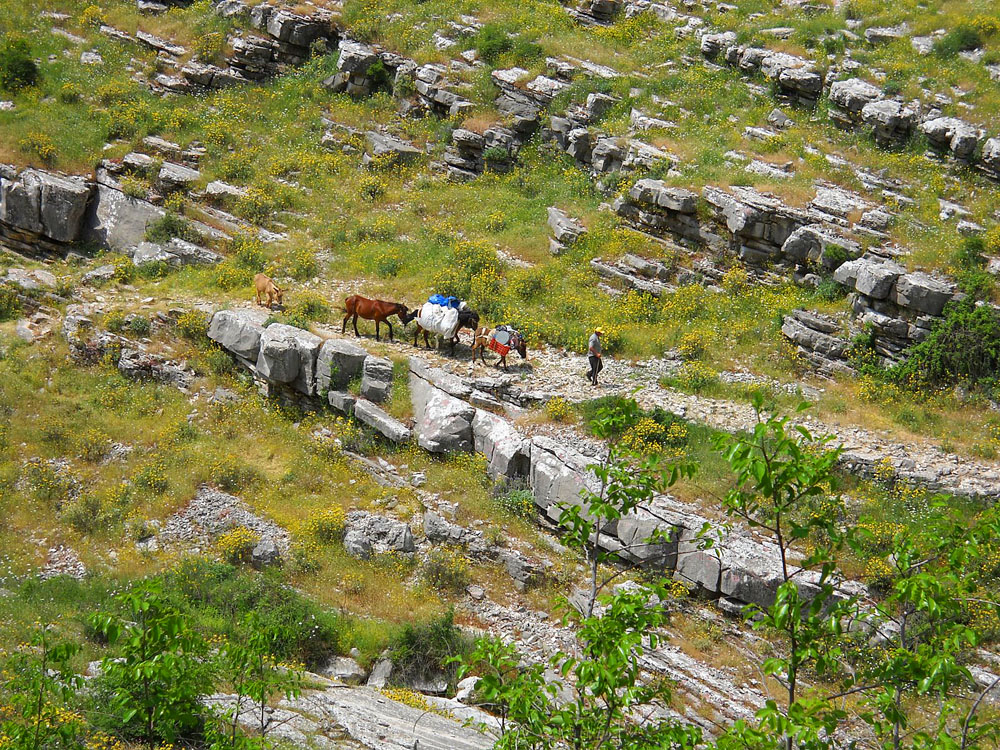
I also wondered what they were eating as they stopped for their midday break. Bread? Cheese? Homemade brew?
Reminiscing about these shepherds made me crave simple fare. Farm food. So today we’re eating oven-roasted radishes.
My dear friend Robin made them for me when I visited her recently. I don’t usually care for radishes with their peppery heat and almost aluminum after taste. But now I crave them.
Somehow roasting mellows the radishes, taking away their distinctive bite. And roasting the leaves is pure genius. They turn into light, crispy, salty bits of loveliness. I made two pans of these and Bear and I ate them clean in one day. They’re that good.
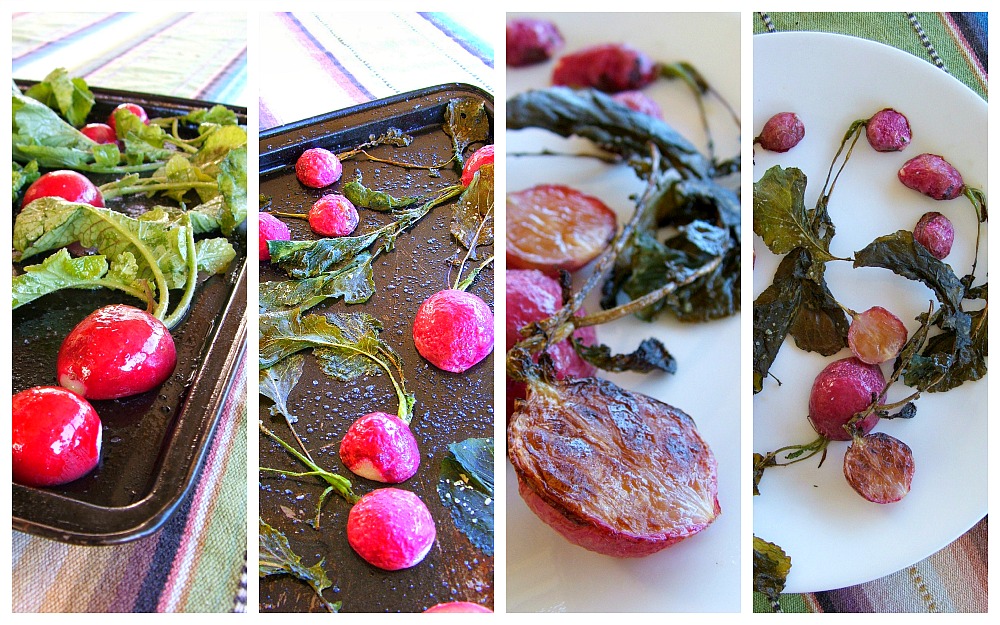
What is the best road trip you’ve ever taken?
Oven-Roasted Radishes
Ingredients:
1 bunch radishes with greens, washed and dried
olive oil
salt
Directions:
- Preheat oven to 400 degrees F.
- Grease baking sheet with olive oil.
- Separate radishes and cut in half. Place on baking sheet cut side down.
- Drizzle with olive oil and sprinkle with salt.
- Roast 20-30 minutes until greens are crispy and radishes are golden brown on cut side.

by Krista | Apr 18, 2012 | Fabulous Friday
After a solid week of hard work I’m celebrating with a caramelized apple pie topped with Havarti cheese. It’s cooling in the kitchen now and smells so ridiculously good.
While I wait for it to be ready I have a few moments to tell you about the projects I told you about yesterday.
The first is a blog for the farm where I live in Australia: Citadel Kalahari. It will be a place for stories about the gorgeous Kalahari and Kalahari Bohr goats I look after each day, homey recipes, and the adventures we have on an Australian goat farm.
You can visit by clicking here: Citadel Kalahari or Citadel Kalahari on Facebook.
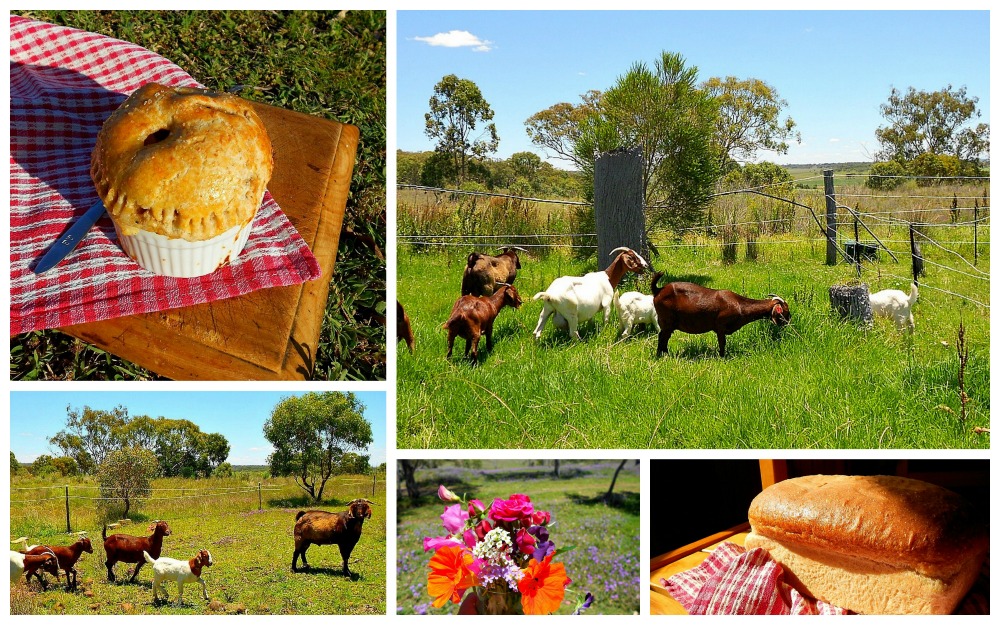
The second is a blog for my dear friend Ann: thisAnnthat. You’ve heard about Ann here before. She’s been an incredible friend to me, welcoming me right into her family and teaching me a myriad of things about gardening, goats and cheese-making. I love her to pieces and am so excited about this new blog of hers where she’ll be sharing recipes and tips for everything from cheeses and breads to ethnic foods from her beloved Hungary.
You can visit by clicking here: thisAnnthat.
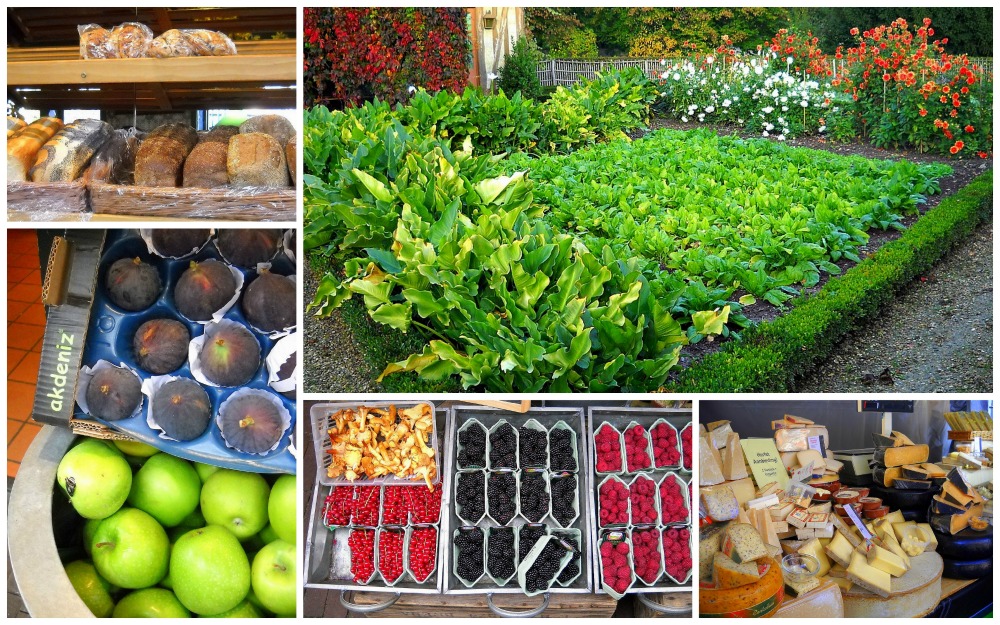
My third project is still in progress, a blog for the Australian medieval enactor group I joined: Black Wolf Caravan. I love this group of crazy folks so much. They are the jolliest bunch and meet at the farm nearly every weekend to eat, brainstorm and make all sorts of fabulous things like chain mail, camel saddles, and weapons from the 12th century. This blog will feature stories of our adventures together, projects, medieval recipes, and educational materials on the life of a trader caravan on the Silk Road during the 12th and 13th centuries.
You can visit by clicking here: Black Wolf Caravan or Black Wolf on Facebook.
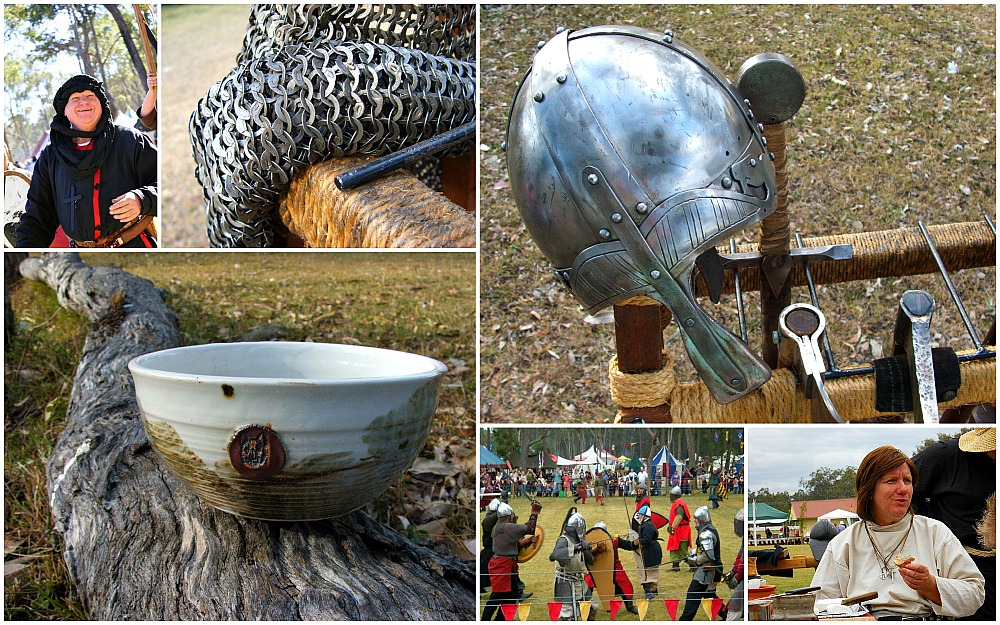
My fourth project this week (phew!) is taking on the role of Community Manager at my beloved Travel Belles (yay!!). I’ve been writing for this wonderful site for nearly two years now and treasure the relationships I’ve forged there.
If you’re interested in travel, reading great books, eating good food or just like being inspired by the adventures of others, I’d love to have you join us. You can join the Travel Belles Community by clicking here:
Travel Belles Community
Travel Belles on Facebook
Travel Belles website
And that, dear friends, is that. 🙂
Now it’s time to head out into the sunshine with a slice of homemade pie.
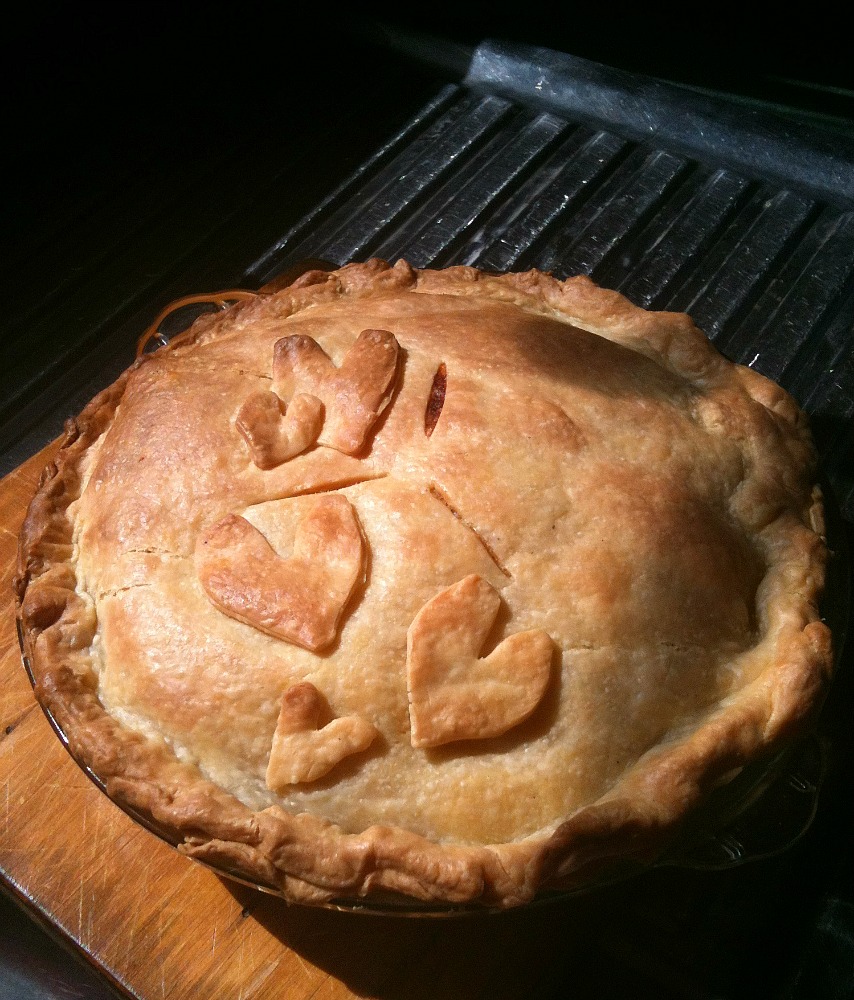
What’s your favorite way to relax after working like a trooper?
Caramelized Apple Pie with Havarti Cheese
Ingredients:
6-8 large apples, cored, peeled and sliced thinly
1/2 cup butter
1/2 tsp each of nutmeg, cardamom, cinnamon and cloves
1/4 cup to 1/2 cup brown sugar
4 slices Havarti (or extra sharp cheddar)
pie crust dough (enough for double crust pie)
Directions:
- Preheat oven to 400 degrees F.
- In large frying pan melt butter over medium heat.
- Add apples and saute 5 minutes until they begin to brown.
- Add spices and saute 5-10 minutes more until apples are browned and softened.
- Add brown sugar and stir until melted and well-mixed. Let simmer 5 minutes.
- While mixture is simmering, prepare pie pan but pressing half of dough into bottom of pie pan.
- Pour apple mixture into pie pan.
- Top with slices of cheese and top layer of dough.
- Brush with beaten egg or melted butter.
- Bake 30-40 minutes or until crust is browned.
- Serve warm.

by Krista | Apr 13, 2012 | Fabulous Friday
Late afternoon sunshine streamed through the windows of Our Lord in the Attic (Museum Ons’ Lieve Heer op Solder) as I continued my exploration of this amazing hidden 17th Century Catholic Church in Amsterdam.
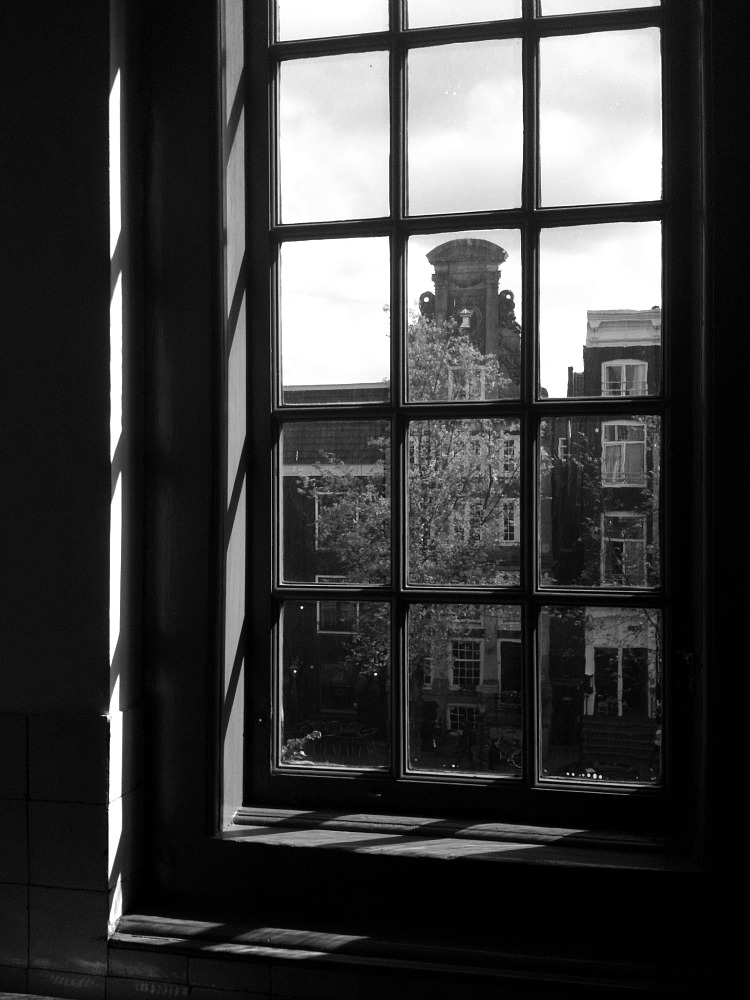
Last time I shared photos from my trusty phone of the beautiful interior of this unique hidden church. (You can view them here.)
Today we will leave the lavish sanctuary and exquisite old organ and enter my favorite part of the museum: the former living quarters of priest Ludovicus Reiniers and his household staff who moved into the Velvet Burgwal (original name for this building) in 1739.
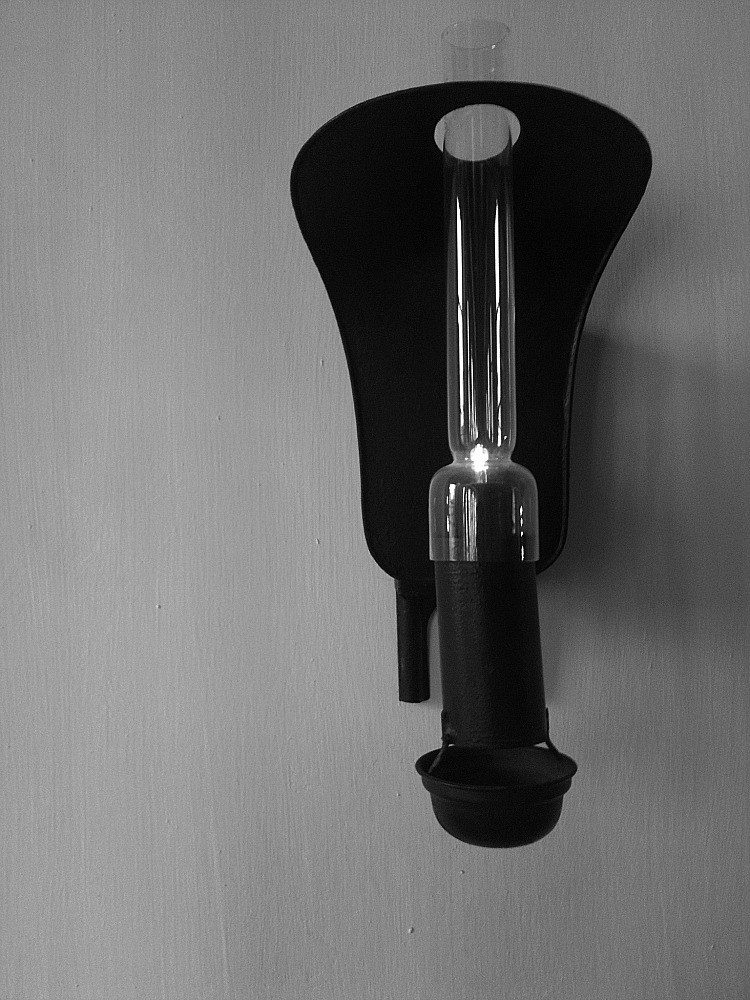
With nearly all furnishings and exhibits removed for an extensive renovation, this part of Our Lord in the Attic is a deeply serene and quiet escape from the hustle and bustle of the city of Amsterdam.
I love the soft winter light of Amsterdam, and it was on glorious display as it filtered through the old, glass, multi-paned windows and settled into warm puddles on the aged wooden planks of the floor.
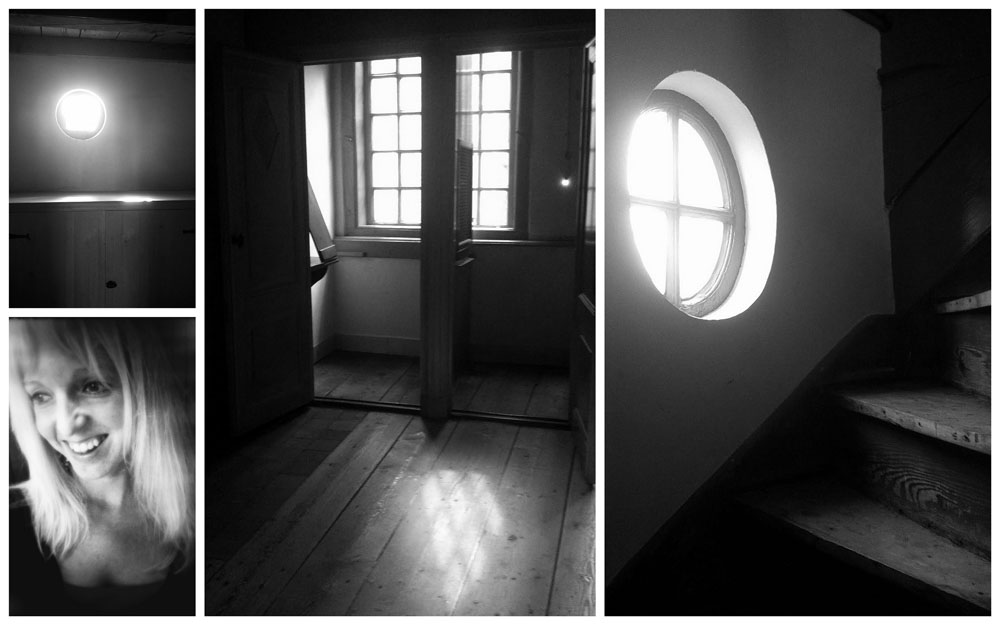
In this quiet setting it was so easy to picture the maid humming to herself as she swept and dusted the staircase after dozens of parishioners clomped up and down the steps to and from the worship service.
Or perhaps the priest hunched over a desk cluttered with books, parchment and fountain pens as he prepared next week’s sermon.
I wondered what sort of furniture they had back then. Would the bed have been piled with a thick down comforter? Would the walls have been lined with bookshelves or big wooden wardrobes?
I would’ve loved a big, squishy chair pulled up to one of those splendid old windows, reading for hours in glorious solitude.
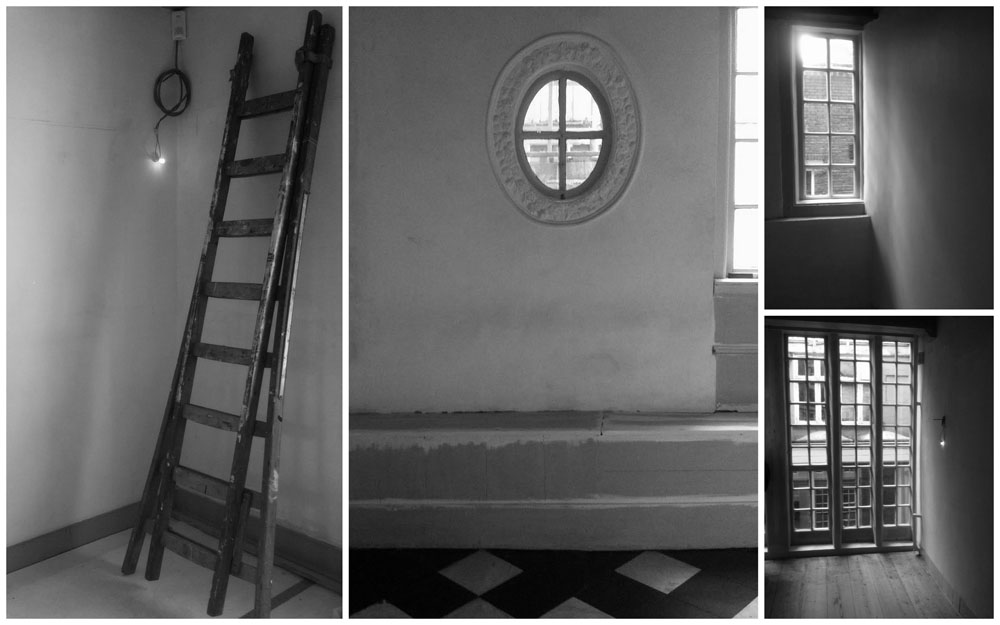
I crept precariously down a particularly narrow and twisting staircase and found the kitchen, a delightful place flooded with soft light and lined with blue and white tiles.
Isn’t it so homey? I can easily picture myself at that old wooden table, sharing a cup of tea and plate of cookies with a dear friend.
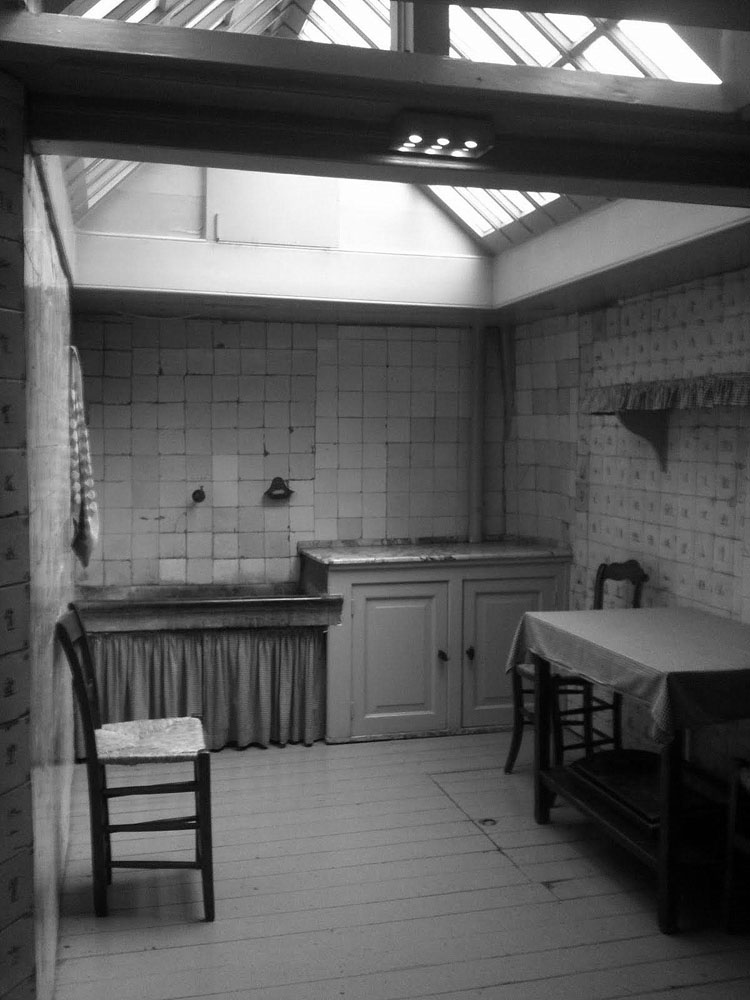
The tiles lining the walls are aged and chipped now, but I love the country scenes depicted: fishing, swinging, walking with a pet.
I wanted to tie on an apron, haul out mixing bowls and start cooking .
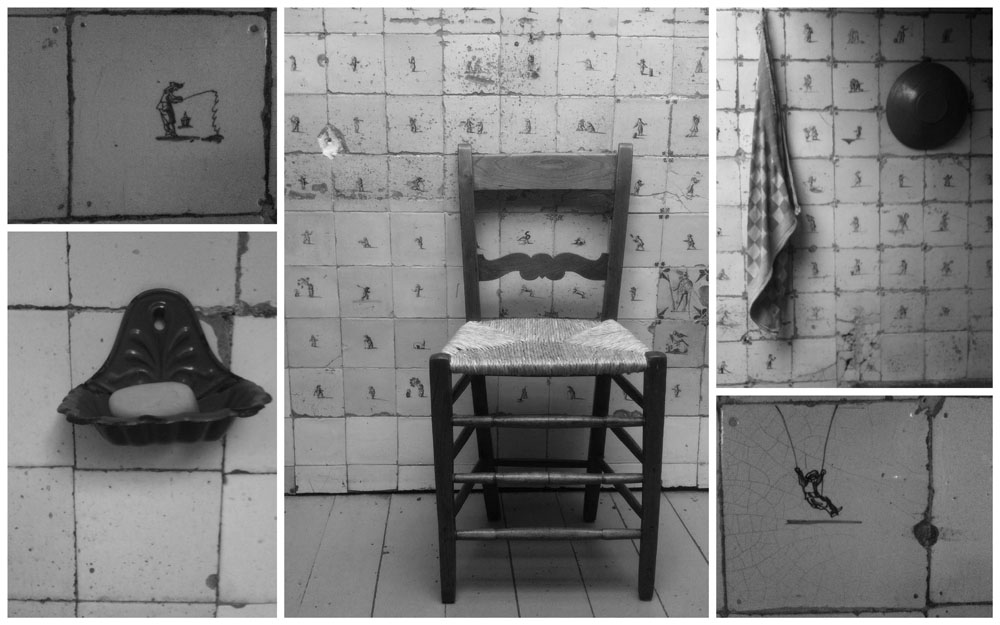
Leaving that splendid old kitchen I entered a light-filled hallway and bid farewell to this most interesting museum. A place rich in history and personalities providing a fascinating glimpse into a bygone world.
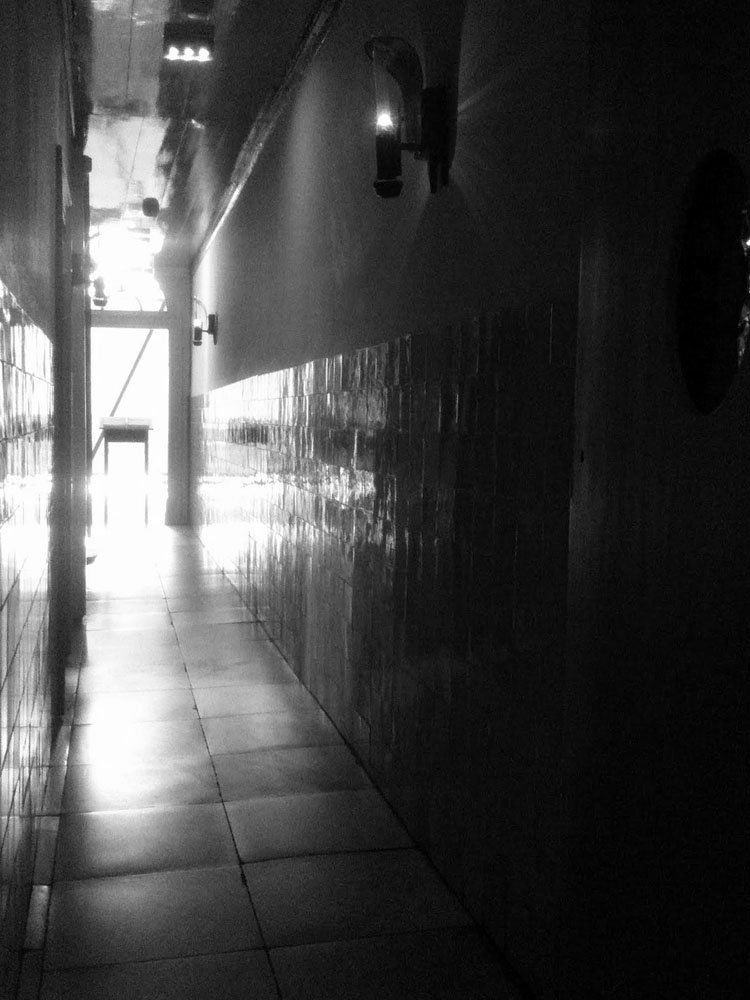
I wrapped my scarf tightly around my neck and headed back into the blustering Amsterdam weather.
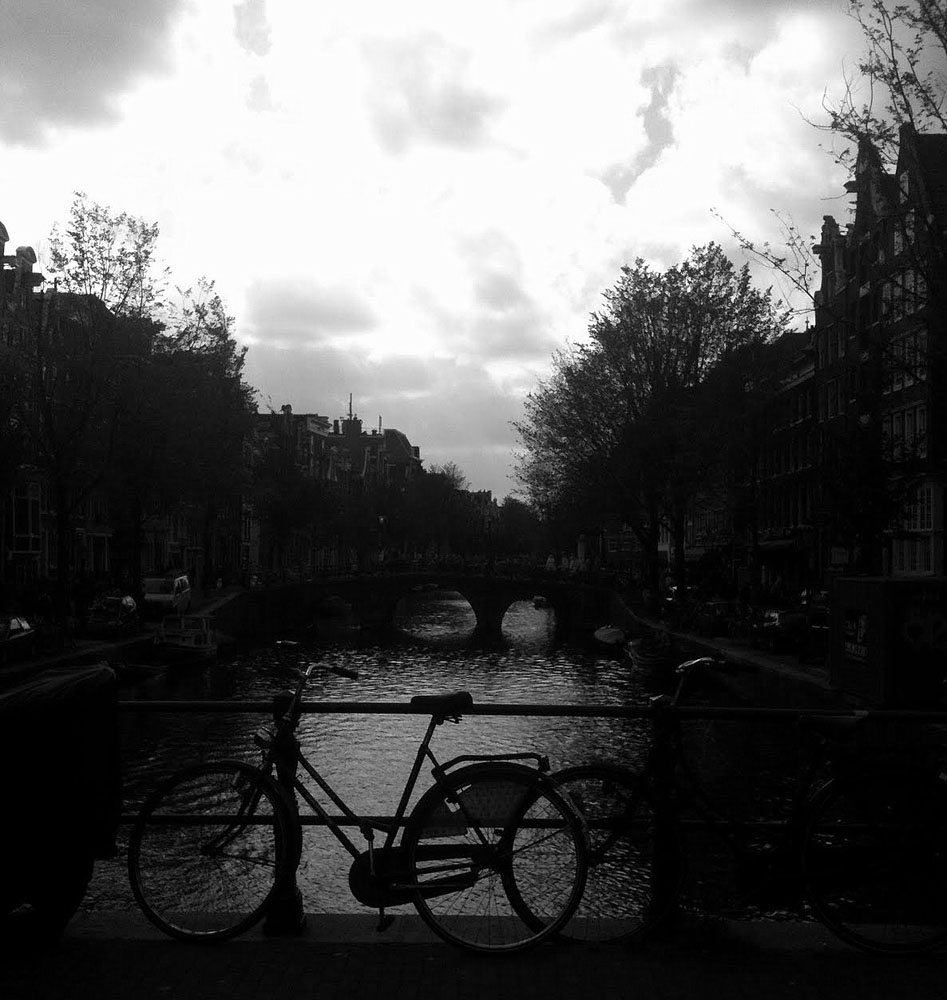
It was time to go home.
What do you picture yourself doing in an old house like this?

by Krista | Apr 5, 2012 | Fabulous Friday
Our Lord in the Attic. The first time I heard the name of this tiny 17th Century Catholic church in Amsterdam, I loved it and knew I simply had to visit.
Although it was wicked cold on the day I chose, I bundled up against the bone-chilling wind and headed out to find Our Lord in the Attic (Ons Lieve Heer op Solder).
My camera had died a sudden and painful death, so I relied on my trusty phone to capture the day for me.
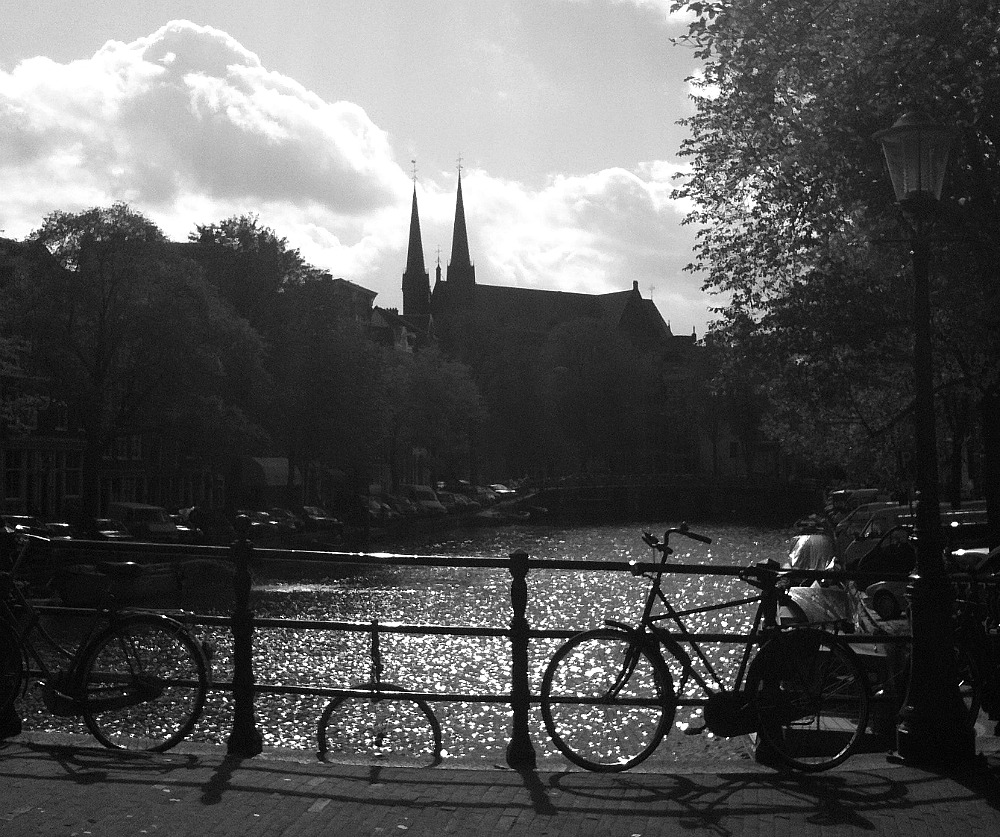
Armed only with a shoddy map whose creator seemed to have felt it unnecessary to be either detailed or accurate, I soon found myself very, very lost. But on such a glorious day I didn’t mind so much, for there were so many interesting things to see.
When the sun comes out in Amsterdam so do the people. Each square and cafe was filled to bursting with students and artists and tourists, soaking up every last precious ray.
As I wandered one canal after another wondering where on earth I was, I’d stumble upon marvelous sights, like the exquisitely detailed rooftops of this unknown church.
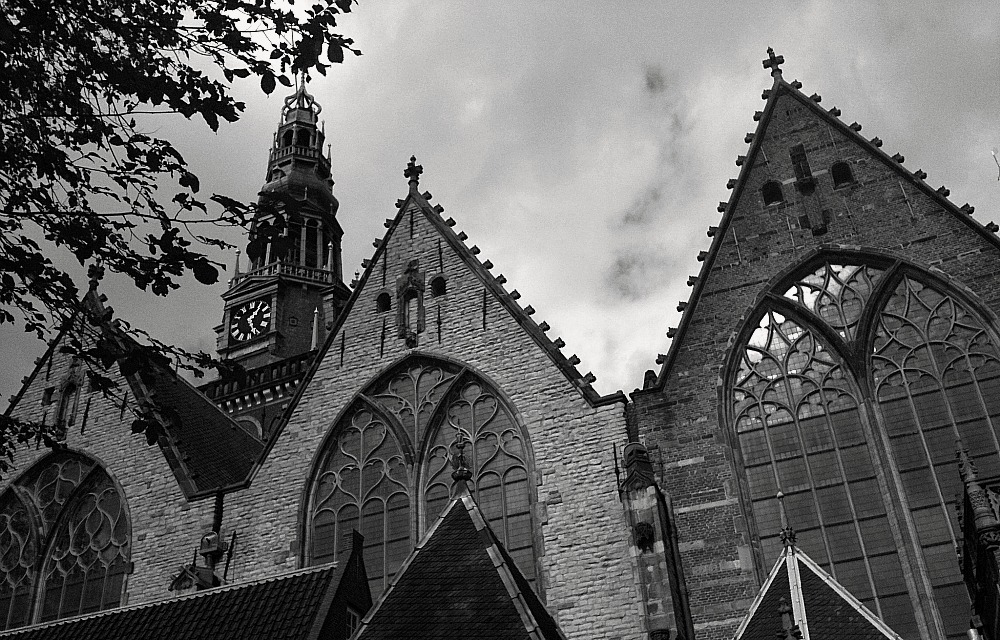
I joined complete strangers for a rest on an obliging bench, listening to them chatter in Dutch, comparing their sketches of monuments and buildings.
I wandered past workmen scaling scaffolding, Turkish men talking animatedly on the cobbled street, and a Dutch fellow working steadily on his houseboat.
I confess I was feeling a tad bit nervous as I discovered I had wandered straight into the middle of the Red Light District which, at that moment, was filled with the sort of leering, creepy chaps that scare the liver out of me. Yipes! But I wasn’t going to let a few brash fellows frighten me, so I lifted my chin, shouldered past them and pressed on.
I had nearly given up hope of ever finding Our Lord in the Attic when suddenly I looked up and there was the banner, flapping in the icy wind. Phew.
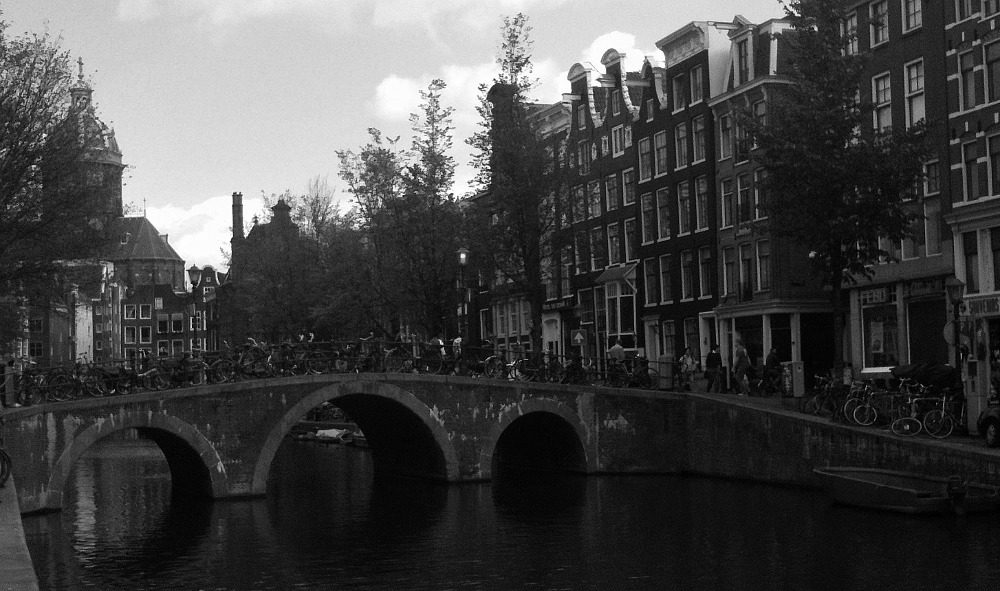
Apart from the banner, there is nothing to suggest that the building is anything more than a traditional canal house, and that’s just the way businessman Jan Hartman wanted it 350 years ago.
I climbed the steps and entered the museum, grateful to be out of the biting winds. I paid for my 8 Euro ticket (about $10.50 US or $10.22 AUD) and was given a handheld gadget that played recorded histories of the various rooms I would visit.
I was the only one there for much of my tour, an unheard of luxury in big city museums. I loved it.
The history of Our Lord in the Attic is absolutely fascinating to me.
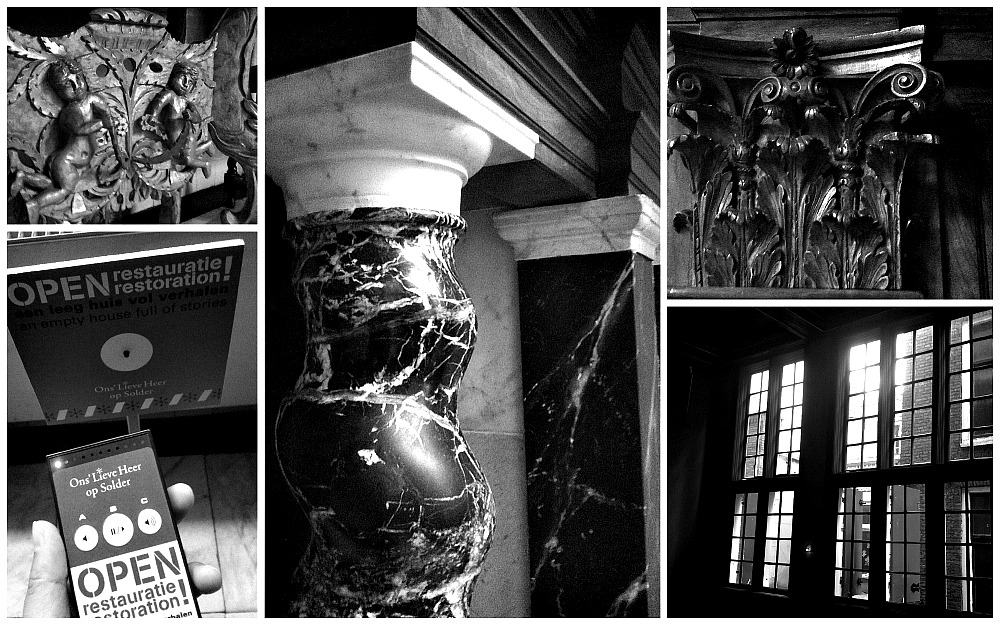
During the Dutch Golden Age (16th-17th centuries) Protestant Amsterdam prevented Catholics from openly practicing their religion. After the transfer of power in Amsterdam to Protestants in 1578, an official prohibition on the celebration of the Catholic mass was issued.
Instead of abandoning their faith, Amsterdam’s Catholics went underground.
In 1661 wealthy merchant and Catholic Jan Hartman (1619-1668) bought the Velvet Burgwal, a prestigious property on Oudezijds Voorburgwal. With his son training for the priesthood, Hartman wanted a place where Catholics could worship in safety. The Velvet Burgwal provided the perfect place to build a secret church.
Comprised of three buildings, one in front and two behind, the Velvet Burgwal’s main floors functioned as a lavish reception room, shop, and storage area. The third floor of the front house formed a single extended attic with the top floors of the two back houses.
For over two hundred years Hartman’s attic served as the parish church for Amsterdam’s city center. While city father’s knew about the “secret” church, their policy of tolerance and Hartman’s wealth and influence secured him freedom of worship as long as he didn’t flaunt it.
Originally known as the Hart church (hart means stag), the space was renamed in the 19th century when the priest Ludovicus Reiniers bought the house. During his renovation, the stag that surmounted the facade disappeared, and the church became known as Our Lord in the Attic.
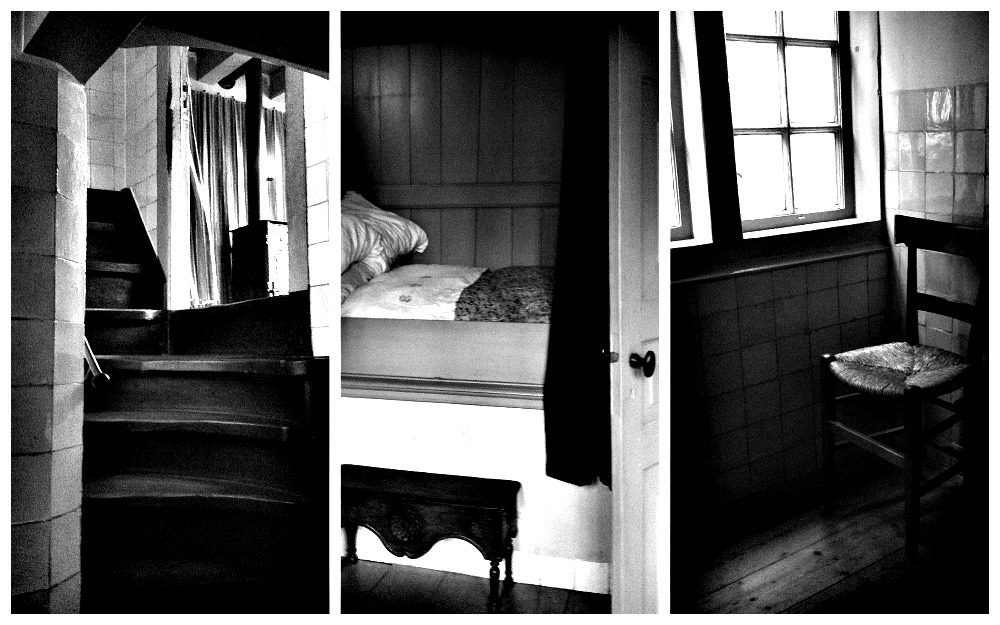
Climbing the steep, narrow staircases up into the heart of the Velvet Burgwal, I could imagine the tramp of many feet as Dutch Catholic parishioners darted in from the street and began the laborious climb into the attic.
I loved the cupboard bed in the corner and the old stove across the room. It’s so cold and damp in Amsterdam in winter that it must’ve been wonderful to crawl in bed at night and pull the curtains shut to seal in precious warmth.
I dipped my hand in the ancient font still affixed to the wall, wondering how many people had performed this ritual over the centuries.
I looked out the tiny windows to the homes across the canal, and pondered what the Golden Age residents thought of the goings on at the Velvet Burgwal.
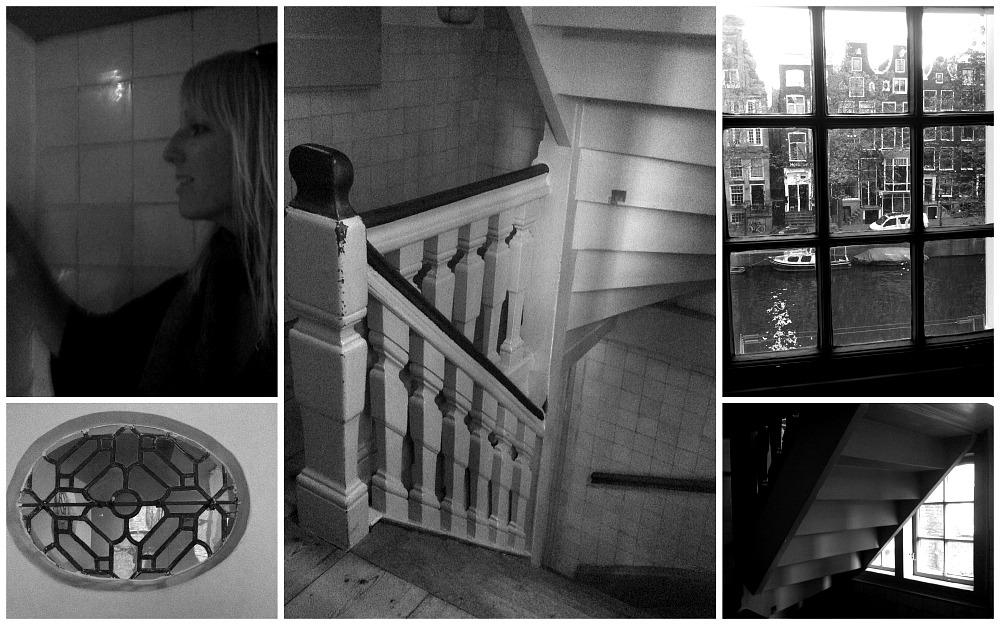
After another few steep sets of creaky wooden steps I emerged into the sanctuary of Our Lord in the Attic.
Late afternoon sun streamed through the windows, light dancing off glossy wood surfaces and brass fixtures. I liked the old black and white photo of a church service in progress. It made the empty space come alive again.
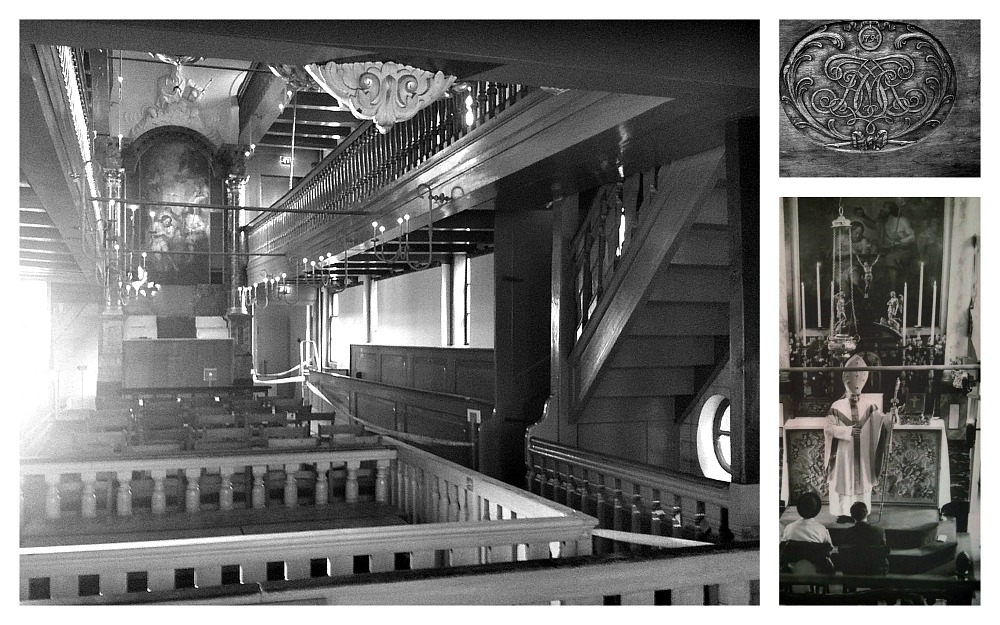 It was strange to come from the plain, simple rooms below into the opulence of this hidden church, but I liked the peaceful feeling it gave. The silence and glorious warmth brought by the sun.
It was strange to come from the plain, simple rooms below into the opulence of this hidden church, but I liked the peaceful feeling it gave. The silence and glorious warmth brought by the sun.
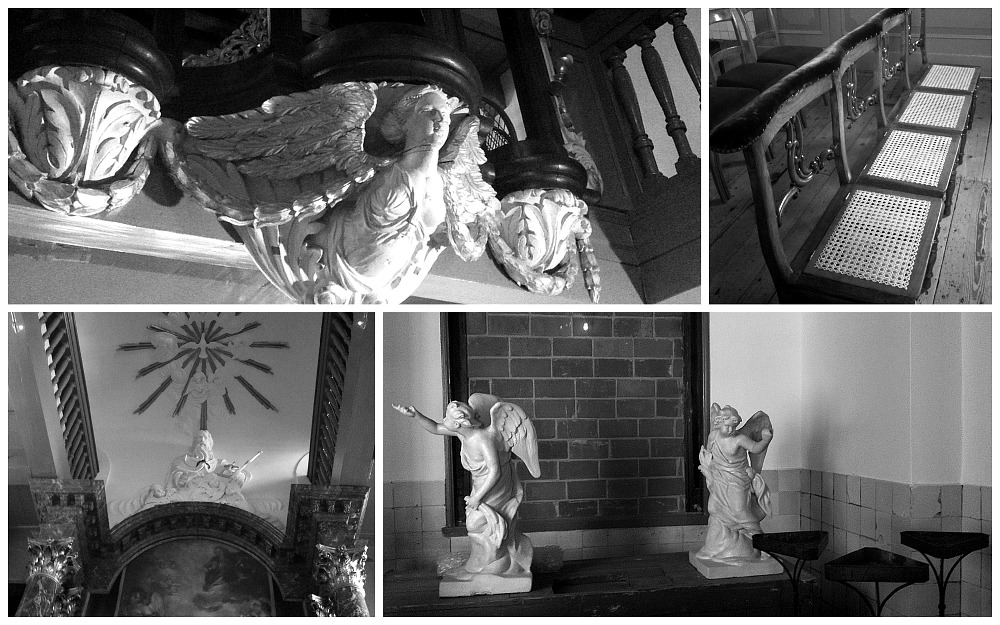
Our Lord in the Attic is currently undergoing a massive renovation. Plans include restoring the neighboring building and providing an underground passage to Hartman’s historical house.
Because of this, most of the facility has been gutted, with all decorations and exhibits removed. While this could be disappointing, I found it quite wonderful. It felt so much more personal with only the walls, floors and windows as they were hundreds and hundreds of years ago. My imagination ran riot, thinking of what I would do in this place if it were mine.
Next time I’ll take you into the quiet rooms of the Velvet Burgwal, where soft light and simple lines created a place of peace and refuge in the 17th century.
What is the most interesting church you’ve ever visited?
Travel Information for Museum Ons’ Lieve Heer op Solder (Our Lord in the Attic)
Oudezijds Voorburgwal 40
1012 GE Amsterdam
T +31(0)20 624 66 04
F +31(0)20 638 18 22
info@opsolder.nl
www.opsolder.nl
Hours:
Monday to Saturday 10.00 – 17.00
Sundays and public holidays 13.00 – 17.00
The museum is closed on 1 January and 30 April
Tickets:
Adults: € 8,00
Children from 6 through 18 years: € 4,00
Children from 0 through 5 years: free
Museumjaarkaart/ICOM/Stadspas/XXXS-pas: free
I amsterdam City Card: free

by Krista | Mar 30, 2012 | Fabulous Friday
While walking along a dirt track skirting the island of Nguna in Vanuatu, I spied a tiny trail leading down to a glimmer of blue.
I can never resist a mystery trail so I clambered down the little hill, stepping carefully over a tangle of vines until I found a gap in the trees and emerged onto this hidden beach.
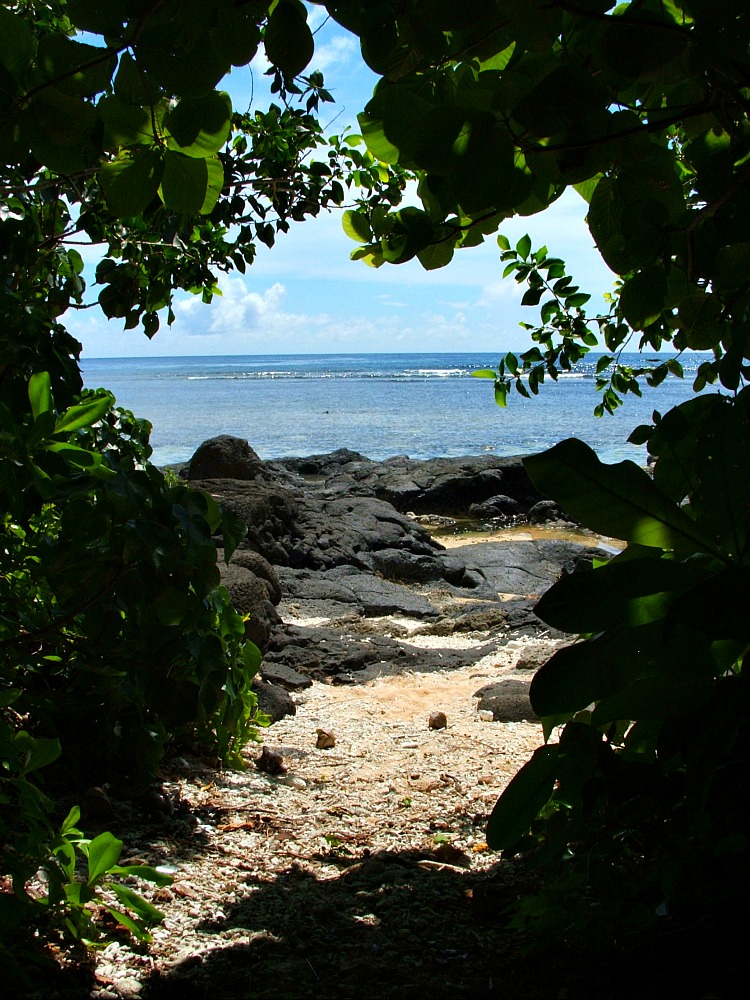
After the relative cool of the bush, the searing heat hit me like a blast from a furnace as I stepped out onto the sand. But the sight of stark black lava rocks from a long dormant volcano was worth the threat of sunburn and heat stroke.

I investigated tidal pools and scrambled atop rocks and sandy cliffs for great views of the Coral Sea and nearby islands.

Peering through another gap in the bush I saw sheets of rain falling across the bay. I was cutting it close with my ambling, but some things are worth risking a drenching.

I loved watching these island children laughing uproariously as they chased each other hand-over-hand around the boat. They caught me smiling at them and waved wildly, calling out hellos at the top of their lungs.
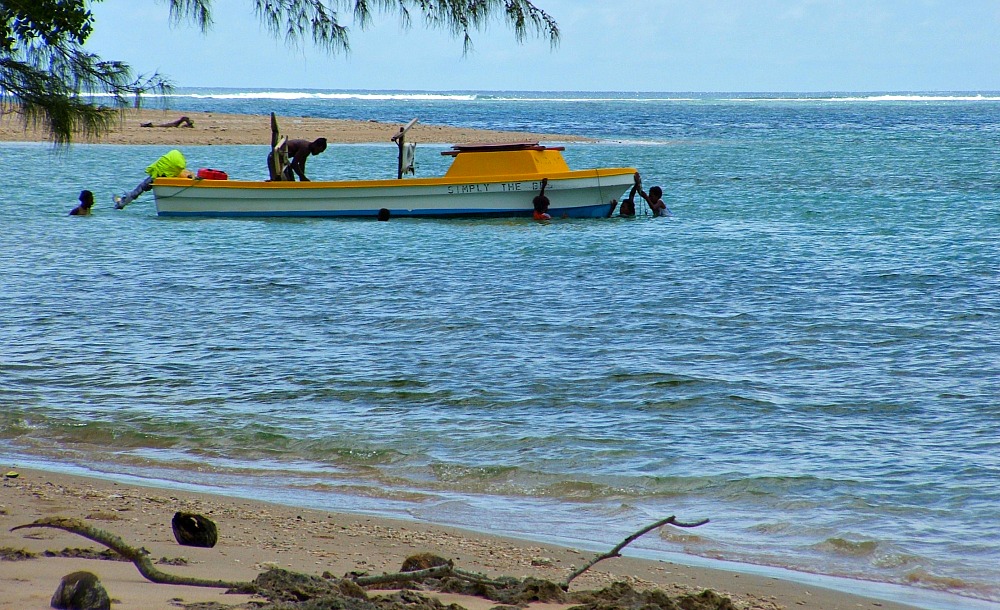
A bit further down the track I came upon these dapper fellows lined up on a fallen log in their Sunday best. I couldn’t resist having a chat with them and had to laugh as they answered each of my questions in loud unison. When asked if I could take their picture they squished closer on the log and assumed their most cool poses, hollering good-bye as I headed back to town.

I glanced out to sea in time to see rain plummeting into the surf only a few yards from shore. I dashed back to my bungalow as the first drops began to fall.
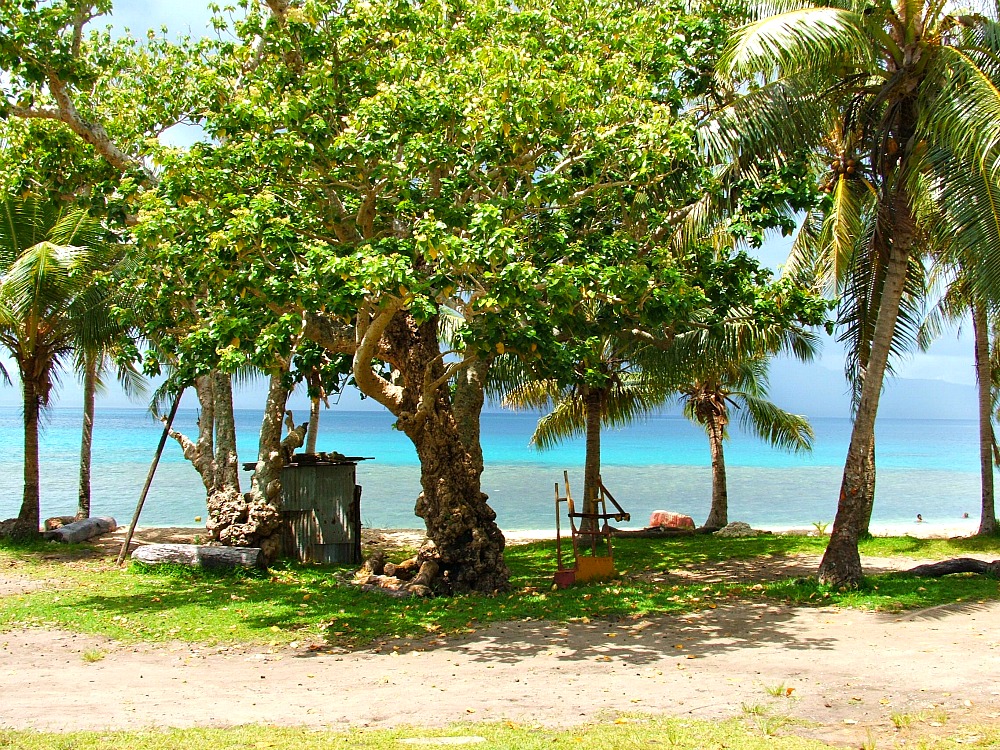
I was in for a doozy of a boat ride across the stormy Coral Sea.
What’s the wildest storm you’ve ever been in?

by Krista | Mar 23, 2012 | Fabulous Friday
After a delectable lunch and leisurely stroll around Locarno, Switzerland, my friends Margo, Katy, Kate, Kathy and I boarded a ferry heading to Stresa, Italy and found the best possible seats in the open air on the top deck.
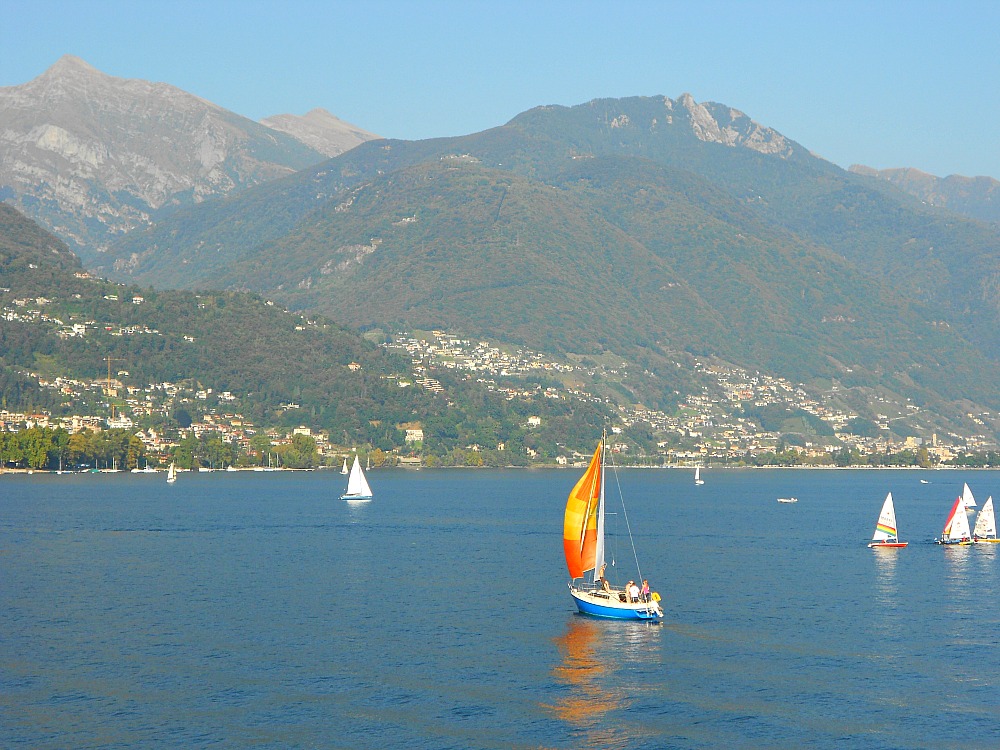
It was the perfect vantage point for soaking up sunshine and watching the bevy of sailboats taking advantage of the Indian Summer for an October sailing.
We met some lovely fellow travelers from Canada and had a good ol’ visit as we steamed along.
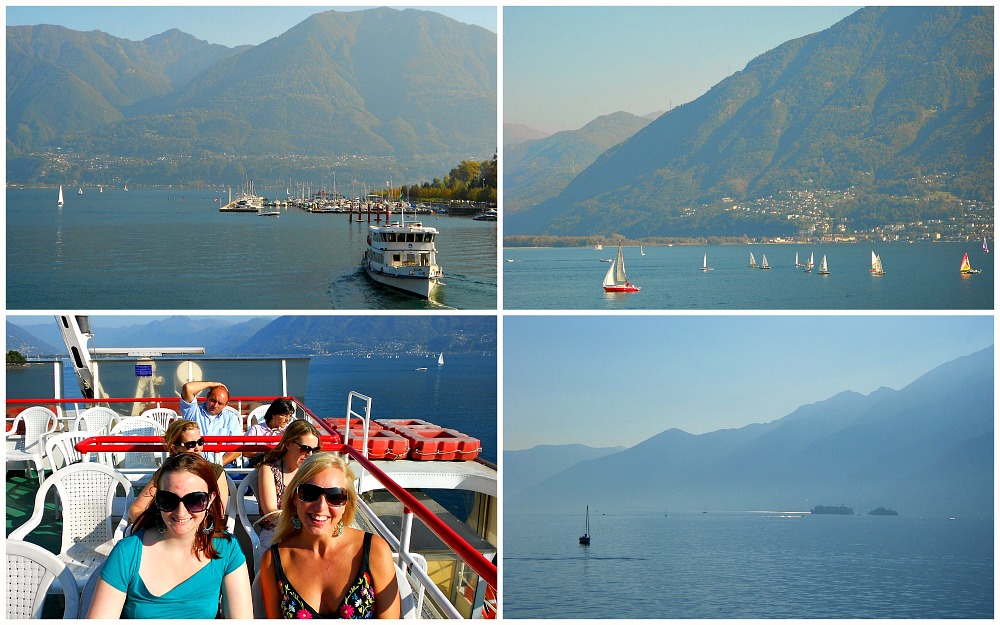
Now and then we’d pull ashore to disgorge passengers, giving us glimpses of pretty little lakeside villages and tidy harbors filled with brightly colored boats.
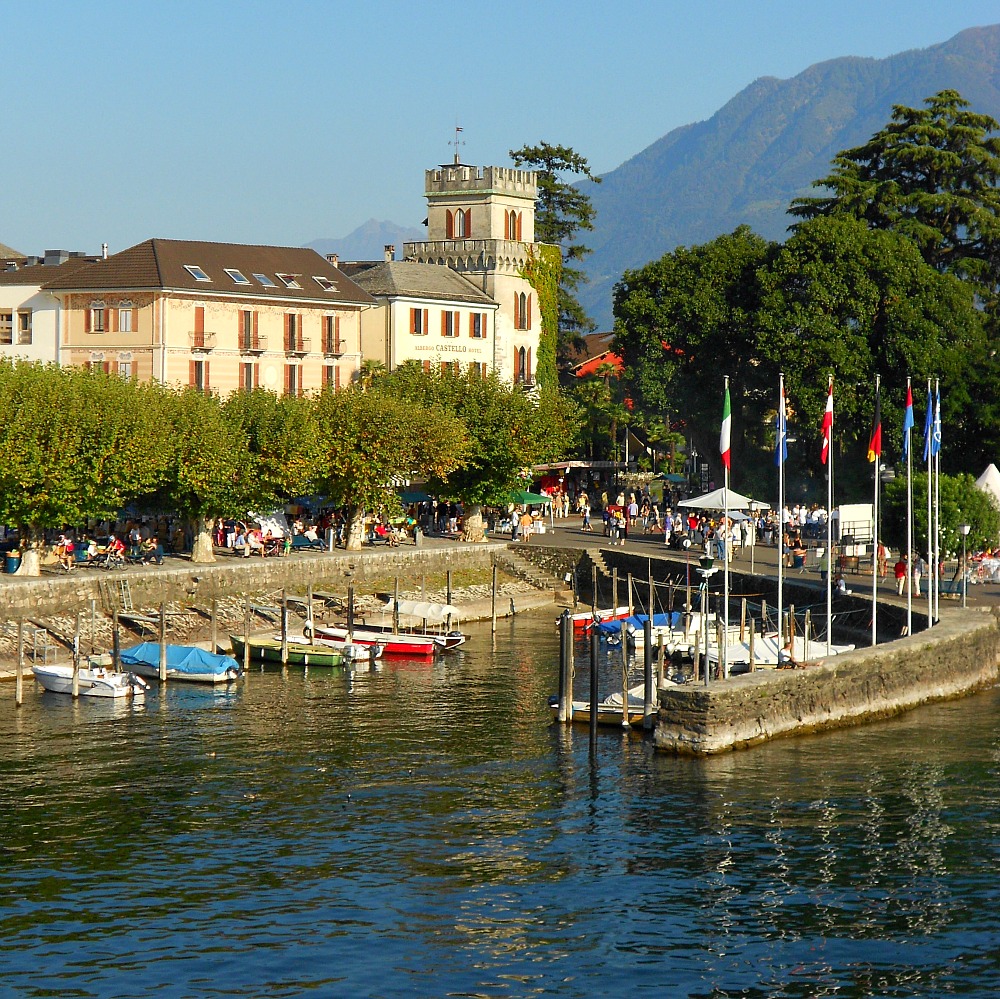
I loved seeing folks walking along the promenade or resting their bones on wooden benches, taking in the sights and enjoying each others company.
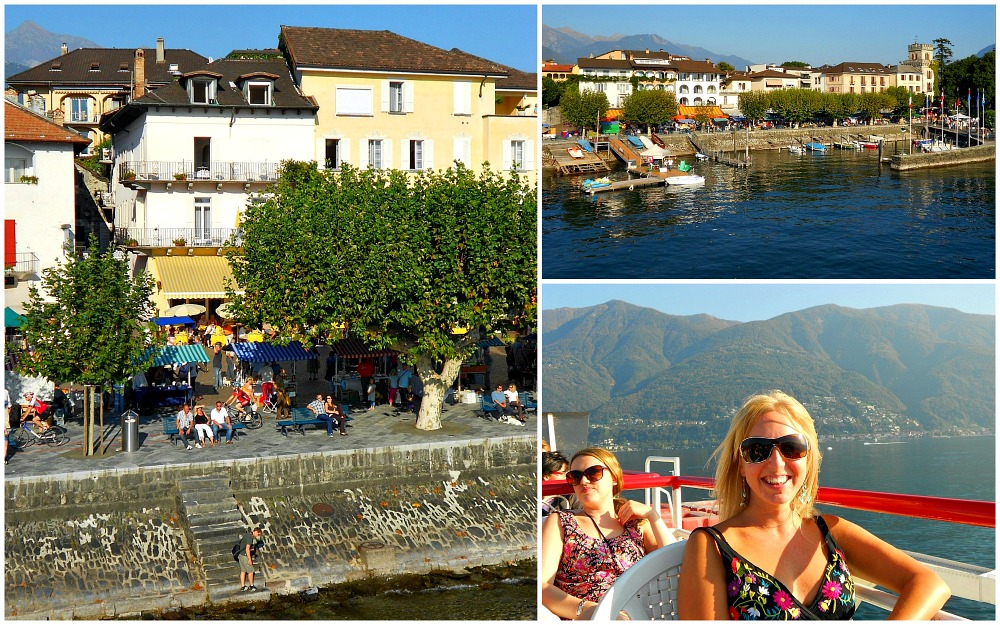
As the sun sank lower in the sky, the ferry took us past the tiny Borromean Islands, their few buildings glowing in the light of the setting sun.
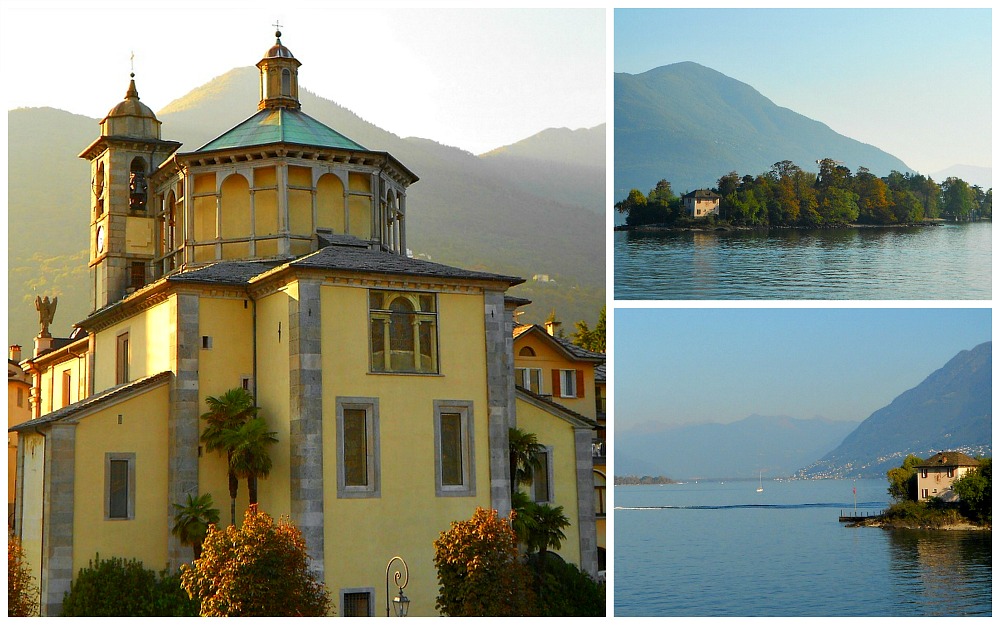
This ferry ride must be gorgeous any time of day, but I’m so glad we got to go at sunset. Everything seems so much more peaceful at sunset. Quiet in the soft golden light.
It didn’t take long for us to settle back in our plastic chairs, escaping into our own private thoughts as we journalled, took photos, and watched the shoreline of Switzerland become the shoreline of Italy.
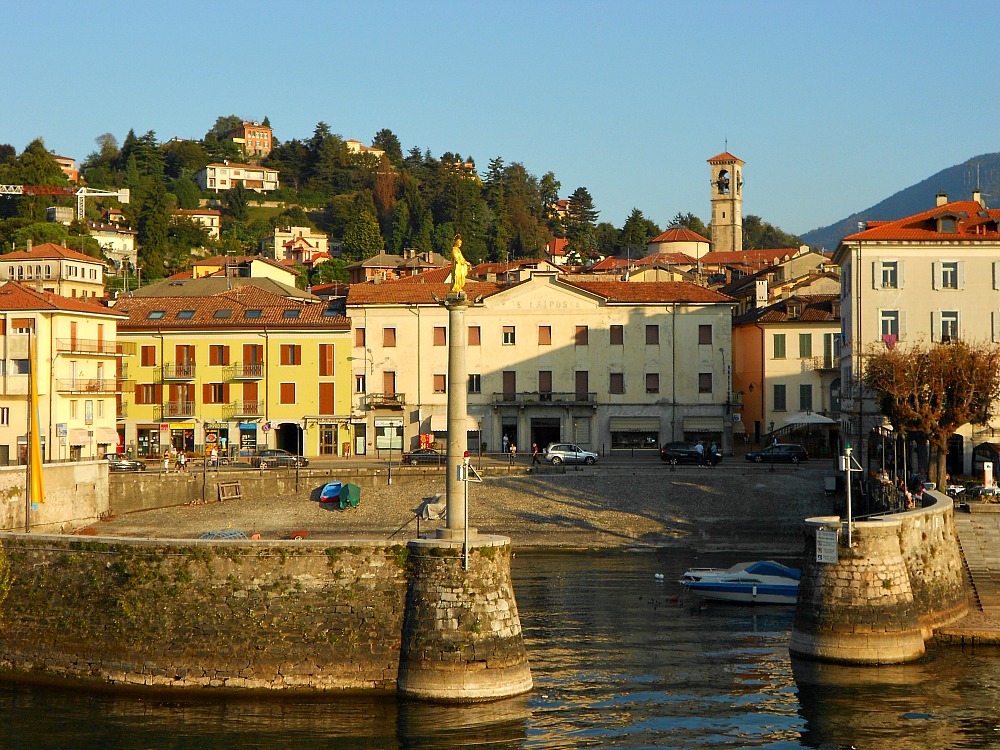
The sun slipped behind the hills and I pulled my pashmina tight around my shoulders, unwilling to leave the deck even with the chilly breezes.
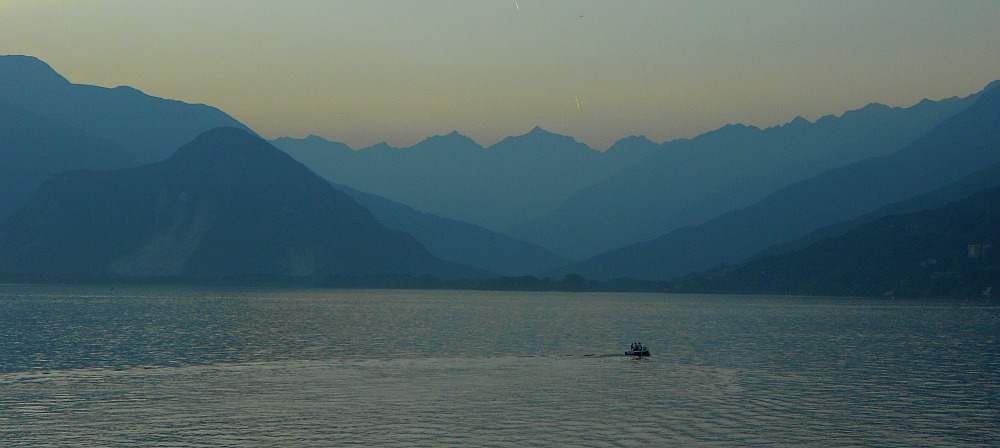
At this point my trusty little camera died and I finished the trip with my phone – islands, old buildings, train station and dear friends. The pictures are blurry and black and white but I love them just the same.
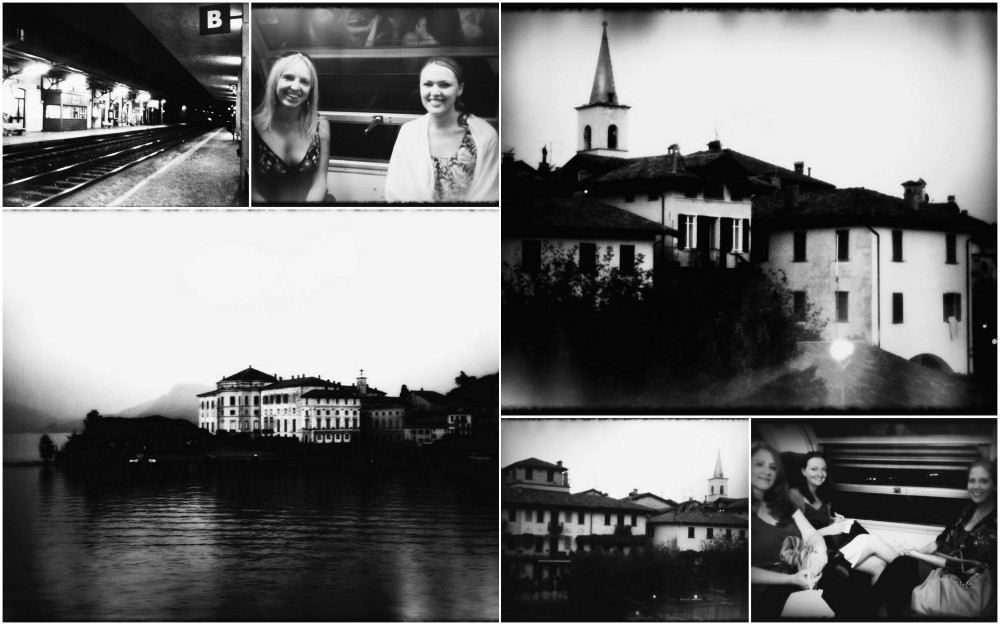
How do you like to document your journeys? Do you write? Take pictures? Video? Paint or sketch?















































